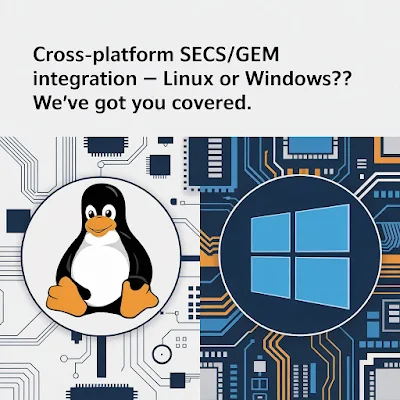In today's competitive manufacturing landscape, factories are embracing advanced technologies to achieve smarter, more efficient operations. Among the many innovations driving this transformation, the SECS/GEM protocol and IoT integration stand out as key enablers of real-time data collection and enhanced process control. This blog delves into how SECS/GEM communication protocols and IoT systems combine to revolutionize industrial environments, creating unprecedented opportunities for manufacturers.
The Role of SECS/GEM in Modern Manufacturing
The SECS/GEM (SEMI Equipment Communications Standard/Generic Equipment Model) protocol has long been a cornerstone of factory automation. Developed to standardize equipment communication, SECS/GEM provides a robust framework for data exchange between manufacturing equipment and host systems. By implementing SECS/GEM software, factories can achieve seamless machine-to-machine communication, enabling better monitoring, control, and optimization of production processes.
One of the key advantages of SECS/GEM communication lies in its versatility. Whether in semiconductor fabs adhering to GEM300 standards or other high-tech manufacturing sectors, the SECS/GEM interface supports a wide range of operations, from equipment diagnostics to recipe management. This standardization ensures interoperability across diverse equipment, reducing integration complexity and enhancing overall efficiency.
Enhancing SECS/GEM Communication with IoT
While the SECS/GEM protocol provides a strong foundation for factory automation, its integration with IoT technologies takes real-time data collection to the next level. IoT systems enable factories to connect machines, sensors, and software into a unified ecosystem, providing real-time insights into operations. By leveraging SECS/GEM communication protocols alongside IoT platforms, manufacturers can unlock new levels of visibility and control.
For example, IoT-enabled sensors can augment the data provided by SECS/GEM software, offering granular insights into machine performance, environmental conditions, and product quality. This enriched data stream allows for predictive maintenance, where potential equipment failures are identified and addressed before they impact production. Additionally, IoT systems can extend SECS/GEM communication beyond individual machines, facilitating real-time monitoring and coordination across an entire factory floor.
A practical application of SECS/GEM and IoT integration is in semiconductor manufacturing, where the GEM300 standard governs the automation of equipment. Here, IoT devices can complement SECS/GEM interfaces by providing additional data points, such as vibration or temperature metrics, ensuring precise control over critical processes.
The Benefits of SECS/GEM and IoT Integration
Integrating SECS/GEM communication protocols with IoT technologies offers a host of benefits, including:
Real-Time Monitoring: The combination of SECS/GEM software and IoT sensors enables continuous data collection, allowing manufacturers to monitor production lines in real time and respond swiftly to anomalies.
Enhanced Process Control: SECS/GEM interfaces standardize equipment communication, while IoT systems provide additional insights, resulting in more precise and adaptive process control.
Predictive Maintenance: IoT-driven analytics, combined with SECS/GEM data, enable predictive maintenance strategies, minimizing downtime and extending equipment life.
Scalability: SECS/GEM communication protocols are inherently scalable, and when paired with IoT, they allow manufacturers to adapt their systems to evolving production needs effortlessly.
Improved Decision-Making: Real-time data from SECS/GEM software and IoT platforms empowers managers to make data-driven decisions, enhancing productivity and product quality.
Implementing SECS/GEM and IoT Solutions
To maximize the potential of SECS/GEM communication and IoT integration, manufacturers must adopt a strategic approach. Choosing the right SECS/GEM software is crucial, as it serves as the backbone of equipment communication. Similarly, selecting IoT devices that seamlessly integrate with SECS/GEM interfaces ensures that data flows effortlessly across systems.
Collaboration between IT and operational teams is another critical factor. While IT professionals focus on setting up robust IoT networks, operational teams can ensure that SECS/GEM communication protocols align with manufacturing goals. Additionally, leveraging cloud-based platforms can further enhance SECS/GEM integration, providing scalable and secure solutions for data storage and analysis.
The integration of SECS/GEM and IoT technologies is reshaping the future of manufacturing, offering unparalleled capabilities for real-time data collection, process optimization, and decision-making. By leveraging the strengths of the SECS/GEM protocol alongside IoT innovations, factories can achieve greater efficiency, adaptability, and competitiveness. Whether implementing GEM300 standards in semiconductor manufacturing or deploying IoT-driven SECS/GEM interfaces across other industries, the opportunities are boundless. Embracing this powerful combination is not just an upgrade—it’s a transformation that positions manufacturers for long-term success.




